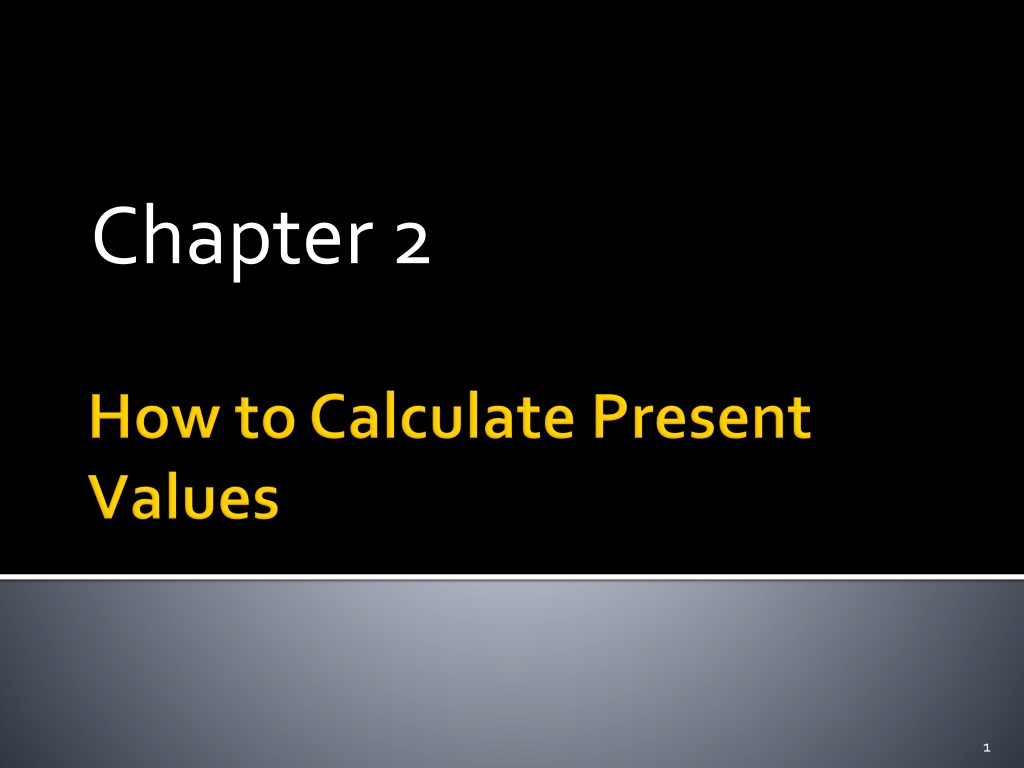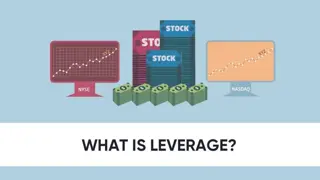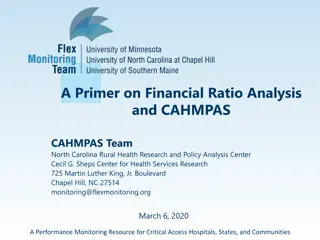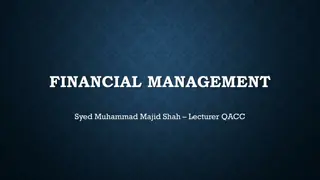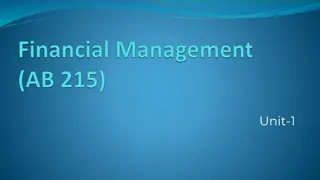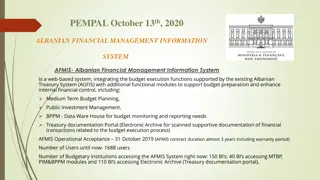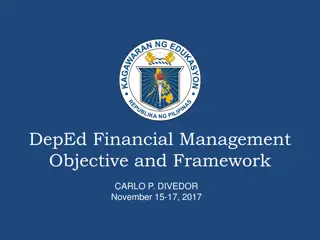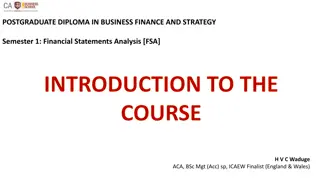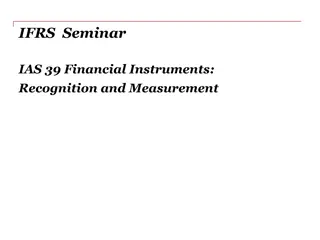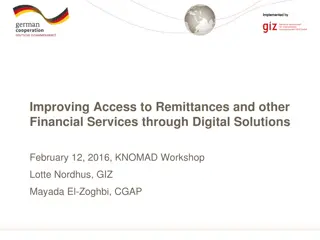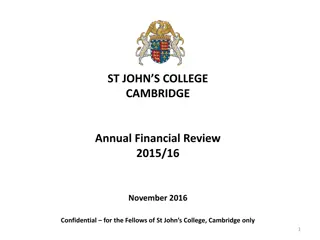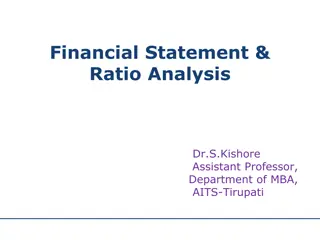Financial Management Principles Overview
This section delves into future values, present values, interest rates, and cash flow forecasting in financial management. It explains concepts like discount factors, perpetuities, annuities, and illustrates calculations with examples. Understanding these principles is crucial for making informed financial decisions.
Download Presentation

Please find below an Image/Link to download the presentation.
The content on the website is provided AS IS for your information and personal use only. It may not be sold, licensed, or shared on other websites without obtaining consent from the author. Download presentation by click this link. If you encounter any issues during the download, it is possible that the publisher has removed the file from their server.
E N D
Presentation Transcript
Future Values and Present Values Looking for Shortcuts Perpetuities and Annuities More Shortcuts Growing Perpetuities and Annuities How Interest Is Paid and Quoted 2
Present Value Value today of a future cash flow. Future Value Amount to which an investment will grow after earning interest 3
Future Value of $100 = FV = 1 ( + t FV 100 $ r) 4
= 1 ( + t FV 100 $ r) $$$$$$$ Example - FV What is the future value of $100 if interest is compounded annually at a rate of 7% for two years? = FV = 100 $ . 1 ( 07 + ) . 1 ( 07 ) 114 49 . FV = 1 ( 2= 100 $ 07 . ) 114 $ 49 . 5
1800 1600 0% 10% 5% 15% 1400 1200 Interest Rates FV of $100 1000 800 600 400 200 0 0 1 2 3 4 5 6 7 9 10 11 12 13 14 15 16 17 18 19 20 Number of Years 8 6
Present value = PV PV = discount factor C 1 7
Discount factor = DF = PV of $1 = DF 1 t + 1 ( r) Discount factors can be used to compute the present value of any cash flow 8
The PV formula has many applications. Given any variables in the equation, you can solve for the remaining variable. Also, you can reverse the prior example. = PV DF C 2 2 = = PV 114 49 . 100 1 2) + 1 ( 07 . 9
120 100 Interest Rates 80 0% 5% PV of $100 10% 15% 60 40 20 0 0 1 2 3 4 5 6 7 9 10 11 12 13 14 15 16 17 18 19 20 Number of Years 8 10
Step 1: Forecast cash flows Cost of building = C0= 700,000 Sale price in Year 1 = C1= 800,000 Step 2: Estimate opportunity cost of capital If equally risky investments in the capital market offer a return of 7%, then Cost of capital = r= 7% 11
Step 3: Discount future cash flows C = = = 800 , 000 PV 747 664 , 1 +r + 1 ( ) 1 ( 07 . ) Step 4: Go ahead if PV of payoff exceeds investment = NPV 747 664 , 700 000 , = 47 664 , 12
NPV = PV - required investment C + +1 NPV = 1 C 0 r 13
Higher risk projects require a higher rate of return Higher required rates of return cause lower PVs $800,000 of PV 1 = C at 7% 800,000 + = = PV 747 664 , 1 .07 14
$800,000 = PV of 12% at C 1 800,000 + = = PV 714 , 286 1 .12 $800,000 = PV of at 7% C 1 800,000 + = = PV 747 664 , 1 .07 15
NPV = PV - required investment NPV = 714,286 - 700,000 $14,286 = 16
Accept investments that have positive net present value Example Use the original example. Should we accept the project given a 10% expected return? 800,000 = NPV = -700,000 + 27 $ , 273 1.10 17
Accept investments that offer rates of return in excess of their opportunity cost of capital Example In the project listed below, the foregone investment opportunity is 12%. Should we do the project? 800,000 investment profit 700 ,000 = = = Return 14.3% or .143 700,000 18
For multiple periods we have the discounted cash flow (DCF) formula C + C + C + = + + + PV .... t r 1 2 0 1 2 t 1 ( ) 1 ( ) 1 ( ) r r T = t C = + NPV C t 0 0 t + 1 ( ) r 1 19
$30,000 $ 870,000 Present value Year 0 1 2 Year 0 -$700,000 30,000/1.12 = $26,786 870,000/1.122 = $693,559 Total = $20,344 20
Sometimes there are shortcuts that make it very easy to calculate the present value of an asset that pays off in different periods. These tools allow us to cut through the calculations quickly. 21
Perpetuity-Financial concept in which a cash flow is theoretically received forever. cash flow = Return present va C lue r = PV 22
Perpetuity-Financial concept in which a cash flow is theoretically received forever. cash flow = PV of cash flow discount rate C1 = PV 0 r 23
Example What is the present value of $1 billion every year, for all eternity, if you estimate the perpetual discount rate to be 10%? = = $1 bil PV billion 10 $ . 0 10 24
Example - continued What if the investment does not start making money for 3 years? ( ) = = $1 bil PV billion 51 . 7 $ 1 . 0 10 3 1.10 25
Annuity-An asset that pays a fixed sum each year for a specified number of years 1 1 = PV of annuity C ) ( t + r 1 r r 26
PV Annuity Factor (PVAF)-The present value of $1 a year for each of tyears PVAF = 1 1 + r t 1 ( ) r r 27
Annuity -An asset that pays a fixed sum each year for a specified number of years. Asset Year of Payment Present Value 1 2 ..t t + 1 C Perpetuity (first payment in year 1) r 1 + C Perpetuity (first payment in year t + 1) t 1 ( ) r r 1 C C Annuity from year 1 to year t + t 1 ( ) r r r
Example Tiburon Autos offers you easy payments of $5,000 per year, at the end of each year for 5 years. If interest rates are 7%, per year, what is the cost of the car? 5,000 5,000 5,000 5,000 5,000 Year Present Value at year 0 0 1 2 3 4 5 = , 5 000 . 1 / 07 , 4 673 ( ( ( ( . 1 ) ) ) ) 2 = , 5 000 / . 1 07 , 4 367 3 = , 5 000 / . 1 07 , 4 081 4 = , 5 000 / . 1 07 , 3 814 5 = , 5 000 / 07 , 3 565 = Total NPV 20,501 29
Example The state lottery advertises a jackpot prize of $590.5 million, paid in 30 installments over 30 years of $19.683 million per year, at the end of each year. If interest rates are 3.6% what is the true value of the lottery prize? 1 1 + = Lottery va lue 19 683 . ( ) 30 036 . 036 . 1 036 . = Value million 5 . 357 $ 30
Annuity due- Level stream of cash flows starting immediately How does it differ from an ordinary annuity? = 1 ( + PV PV ) r Annuity due Annuity How does the future value differ from an ordinary annuity? = 1 ( + FV FV ) r Annuity due Annuity 31
= 1 ( + FV FV ) r AD Annuity Example: Suppose you invest $429.59 annually at the beginning of each year at 10% interest. After 50 years, how much would your investment be worth? 1 1 .10(1 + .10)50 1.1050 1.10 ????= $429.59 .10 = $550,003.81 32
Example -Annuity You are purchasing a TV for $1,000. You are scheduled to make 4 annual installments. Given a rate of interest of 10%, what is the annual payment? $1,000 = PMT 1 1 + 10 . 4) 10 . 1 ( 10 . = PMT 315 $ 47 . 33
Future Value of an Annuity The future value of an asset that pays a fixed sum each year for a specified number of years. ( ) t + 1 1 r = FV of annuity C r 34
Example What is the future value of $20,000 paid at the end of each of the following 5 years, assuming your investment returns 8% per year? ( ) 5 + 1 08 . 1 = FV 20 000 , 08 . = 117 $ 332 , 35
C = PV 1 0 r g g = the annual growth rate of the cash flow 36
NOTE: This formula can be used to value a perpetuity at any point in time. C = +1 t PV C = t PV 1 r g 0 r g 37
Example What is the present value of $1 billion paid at the end of every year in perpetuity, assuming a rate of return of 10% and a constant growth rate of 4%? 1 = PV0 10 . 04 . = 16 $ 667 . billion 38
Effective Annual Interest Rate Interest rate that is annualized using compound interest Annual Percentage Rate-Interest rate that is annualized using simple interest 39
Annual Percentage Rate (APR): APR = MR 12 Effective Annual Interest Rate (EAR): = + 12 EAR 1 ( MR ) 1 *where MR = monthly interest rate 40
Example: Given a monthly rate of 1%, what is the effective annual rate (EAR)? What is the annual percentage rate (APR)? 41
Example: Given a monthly rate of 1%, what is the effective annual rate (EAR)? What is the annual percentage rate (APR)? 12 EAR = (1 + .01) 1 - = r 12 EAR = (1 + .01) 1 - = .1268 12.68% or 12 APR = .01 = 12.00% or .12 42
